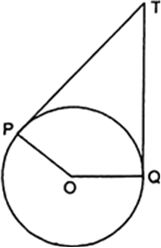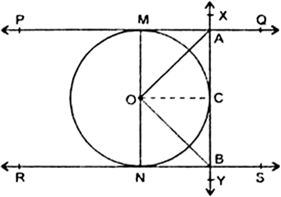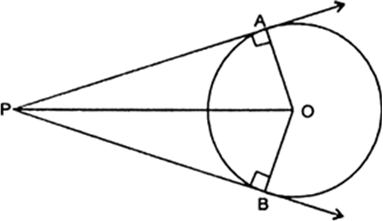Constructions
The length of a tangent from a point A at distance 5 cm from the centre of the circle is 4 cm. Find the radius of the circle.
Since, the tangent at any point of a circle is perpendicular to radius through the point of contact.
Therefore, ∠OPQ = 90°
It is given that OQ = 5 cm
and PQ = 4 cm
In right ΔOPQ, we have
OQ2 = OP2 + PQ2
[Using Pythagoras Theorem]
OP2 = OQ2 – PQ2
⇒ OP2 = (5)2 – (4)2
= 25 – 16 = 9
⇒ OP = 3 cm
Hence, the radius of the circle is 3 cm.
Sponsor Area
Some More Questions From Constructions Chapter
In Fig. 10.11, if TP and TQ are the two tangents to a circle with centre O so that ∠ POQ = 110°, then ∠ PTQ is equal to
(A) 60° (B) 70°
(C) 80° (D) 90°
Fig. 10.11
If tangents PA and PB from a point P to a circle with centre O are inclined to each other at angle of 80°, then ∠ POA is equal to
(A) 50° (B) 60°
(C) 70° (D) 80°.
Prove that the tangents drawn at the ends of a diameter of a circle are parallel.
Prove that the perpendicular at the point of contact to the tangent to a circle passes through the centre.
The length of a tangent from a point A at distance 5 cm from the centre of the circle is 4 cm. Find the radius of the circle.
Two concentric circles are of radii 5 cm and 3 cm. Find the length of the chord of the larger circle which touches the smaller circle.
A quadrilateral ABCD is drawn to circumscribe a circle. Prove that
AB + CD = AD + BC.
In Fig. 10.13, XY and X′Y′ are two parallel tangents to a circle with centre O and another tangent AB with point of contact C intersecting XY at A and X′Y′ at B. Prove that ∠ AOB = 90°.

Fig. 10.13
Prove that the angle between the two tangents drawn from an external point to a circle is supplementary to the angle subtended by the line-segment joining the points of contact at the centre.
Prove that the parallelogram circumscribing a circle is a rhombus.
Mock Test Series
Sponsor Area
NCERT Book Store
NCERT Sample Papers
Sponsor Area